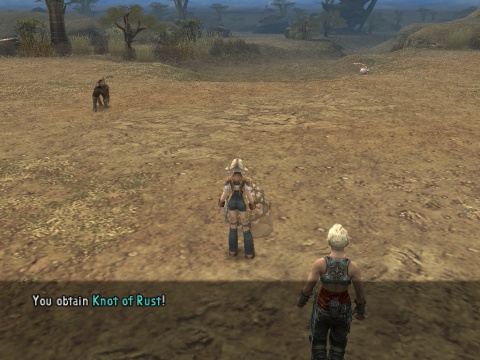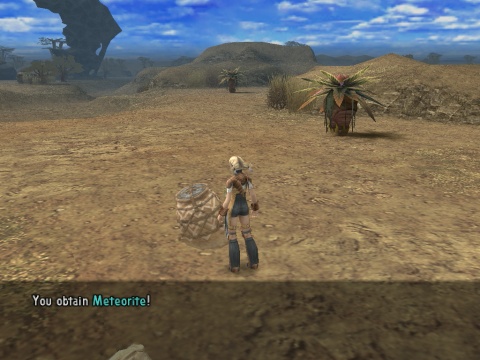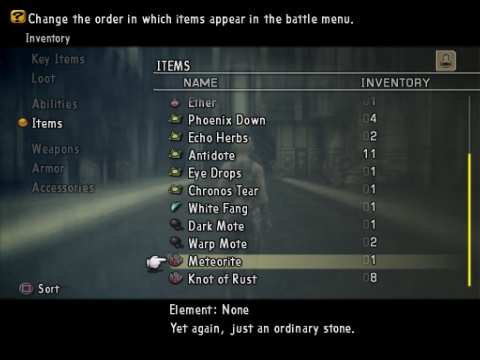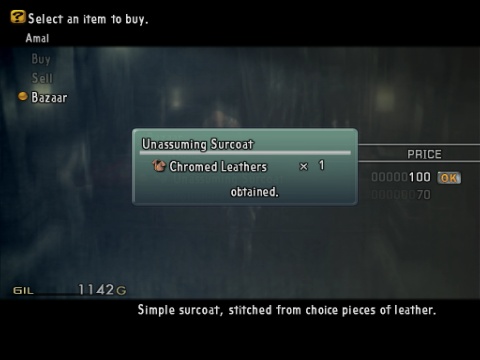Part 8: Recitation Notes 2: Making Effective Use of Library Resources
 Recitation Notes 2: Making Effective Use of Library Resources
Recitation Notes 2: Making Effective Use of Library ResourcesThe dirty little secret of FFXII, and of IZJS in particular, is that you basically never need to buy equipment. Between drops and steals, the treasure system, and the Bazaar, free or early stuff is just there waiting for a dedicated player to seek it out. The first option is straightforward, so let's look at the other two.
X Marks The Spot, 37.5% Of The Time
FFXII's treasure system is a grindy and byzantine thing designed more like an MMO than a CRPG. Every treasure chest in the game is assigned the following pieces of data;
- a chance to appear,
- whether the chest appears again after being opened,
- whether opening the chest causes other chests to disappear,
- a chance to contain items,
- a gil value,
- two normal item drops,
- a common special drop, and
- a rare special drop.
When the player enters a zone, each chest randomly spawns or not based on its chance to appear. Normally, when a chest is opened, the game checks to see if it contains an item. If it does, each of the two normal item drops has an equal chance of being the contents of the chest. If the chest does not contain an item, it contains a random amount of gil, up to the chest's gil value.
IZJS made a couple of changes to the treasure system to make it smarter and fairer. One-time chests now contain the same item in all four of its possible drop slots, so you get the same thing no matter what the RNG does. Also, one-time chests will only cause other one-time chests to disappear if they contain the same item, like Magick or a rare weapon, so while quantities of these may be limited, you can never miss out on them permanently. Most importantly, treasure now spawns every time a zone is entered, whereas in vanilla FFXII treasure would not respawn until the player moved three zones away. The basic system, though, remains unchanged.
(For the programming-inclined, the game's random number generator uses a Mersenne twister in conjunction with the modulo operator to generate high-entropy random numbers between a given range. For example, to generate a number between 0 and 99 (for checking the success of a percentage chance) the RNG generates a random number between 0 and 232-1 and then just uses the last two digits. The nice feature of this approach is that the big number has the potential to change without the last two digits changing, so there is little bias against repeats; if you roll a d100 and get 17, your next roll will be 17 again 1% of the time. So while the RNG for the game is well-understood and completely deterministic, the percentages for random things like chests are still accurate for the average player.)
The Diamond Armlet is an important accessory because it changes the rules of the treasure system slightly. With the Diamond Armlet equipped, chests that contain items will pull from their special drops rather than their normal drops. The description on the accessory says that it yields "superior treasure," but that's not necessarily the case; some chests have useless items for special drops and very powerful ones for normal drops, and there's no way to know in advance without a treasure list. Also, rather than having an equal chance of appearing, the Diamond Armlet drops have a common drop and a rare drop, and the rare drop only appears 5% of the time (down from 10% in the original).


IZJS gives the player the Diamond Armlet much earlier in the game than vanilla FFXII did, and the contents of treasures has been somewhat standardized with this in mind. The normal drops for most chests are usually two consumable items or one consumable item and one piece of equipment of appropriate tier for the area. On the other hand, the common Diamond Armlet drop is usually a Knot of Rust, an attack item whose strength is limited by the user's max HP, and the rare drop is one of four types of Meteorite, new attack items in IZJS of increasing rarity and strength. Both of those Diamond Armlet drops are nice to have for specific instances, but usually a better weapon will be more useful in the long run than a strong one-shot item.

(As for what the Meteorites do, the game doesn't actually tell you. This one, the most common kind, inflicts Sap with a 100% success rate. Later ones can inflict massive damage, enough to one-shot some bosses, but they're so rare that using one as an experiment is kind of foolish. I'll highlight the others when we start collecting them.)
So the decision of whether to use a Diamond Armlet usually depends on the current state of the party; if you're low on Potions or behind the equipment curve, keep it off, but if you're doing fine, you might as well put it on and gamble on useful items to bank for later.
How Bazaar
As for the Bazaar, this is a gameplay element I actually really like, even with minor complains about the implementation. Unlike most Final Fantasies, non-humanoid enemies usually don't carry gil, and useful or valuable equipment is quite rare as well. Instead, most of the items dropped by beasts and monsters are things like pelts, fangs, feathers, tails, and eyeballs, as well as various flavors and sizes of magicite. These items are collectively known as "loot", and they largely serve no direct purpose (with a couple key exceptions) but selling loot is the primary source of gil for much of the game. The scarcity of money in the early game trains the player to obsessively steal from every enemy to maximize the rate at which fungible goods are obtained.
Once you sell loot at any shop, it has entered the wider marketplace, for craftsmen and artisans to do with as they please. When the marketplace is sufficiently saturated, these supplies enable the creation of weapons, items, and more, which can then be bought through that same marketplace. This is abstracted in the game by the Bazaar, which can be accessed from any shop.
There are a number of Bazaar recipes in the game that require a set number of certain kinds of loot. Once those amounts of those items have been sold, a package becomes available for purchase in the Bazaar. The contents of the package aren't known until it is purchased, but the name and description often provide a hint. A couple of details to note;
- It doesn't matter whether you sell the loot all at once or a piece at a time, nor does it matter whether you sold it all to the same vendor. The Bazaar is shared between all shops, and everything you've ever sold, no matter where, counts toward unlocking Bazaar packages.
- Some packages have overlapping requirements. For example, Package A might require two Wolf Pelts, and Package B might require one Wolf Pelt and a Cactus Fruit. Multiple packages can be unlocked if their requirements are met simultaneously -- in this example, selling two Wolf Pelts and a Cactus Fruit would unlock both A and B.
- However, buying a package will clear the items that unlocked it from your record. For example, selling a Wolf Pelt and a Cactus Fruit would unlock Package B. If you were to purchase B, then sell another Wolf Pelt, Package A would not unlock; buying B would set your count of Wolf Pelts to zero, so you would be one Pelt short.
- Most packages can only be bought once, but some can be unlocked and repeated an infinite number of times. These packages usually contain restoratives or loot used to unlock other packages.

For most of the game, the progression of the Bazaar is balanced well to the progression of the game. In general, the packages you can unlock from the loot dropped by monsters you're strong enough to fight will provide equipment slightly stronger or slightly cheaper than you can currently buy from shops. However, there are a handful of Gotcha! packages which are either worthless or cost more than buying the items from the store would. IZJS tweaked the balance slightly, and also changed some monster drops such that loot used in Bazaar packages is no longer available in limited quantities, so you can't screw yourself out of 100% Bazaar completion. (Speaking of 100%, the occasional tally of Bazaar packages you'll see at the end of videos won't include repeatable packages.)
Pop quiz: What do both of these systems have in common? They both want you to buy the strategy guide. Most of the useful treasures will only drop about 25% of the time, and far too many Bazaar packages require grinding rare steals or rare monsters, so the chance of stumbling on them is low. This works okay in an MMO because it encourages cooperation and communication among the user base, but it's just kind of mean in a CRPG.
There's a lot of stuff in this game intended to frustrate completionists, and the treasure and Bazaar mechanics are no exception. On the other hand, they both have the side effect of adding to your money pile. Grinding treasure will save you from having to buy most equipment, and half the time you'll get gil from the chests you open anyways. And if you're diligently hoarding loot to unlock Bazaar packages, you'll get a lot of money from selling it as well. Thanks largely to the treasure system, money's actually easier to come by in IZJS than in the original, which I think was a deliberate design choice. Since your entire party doesn't get to learn healing and buffing Magick any more, items are more important than they used to be.